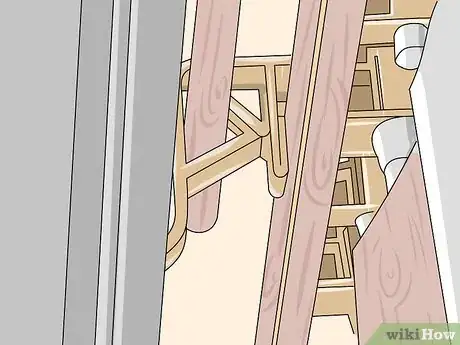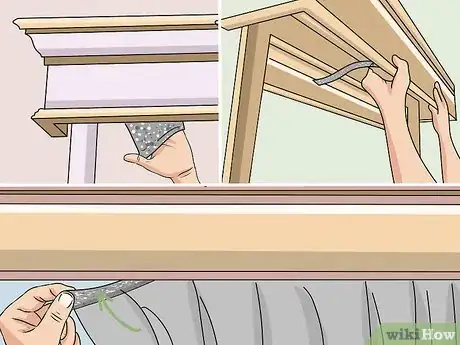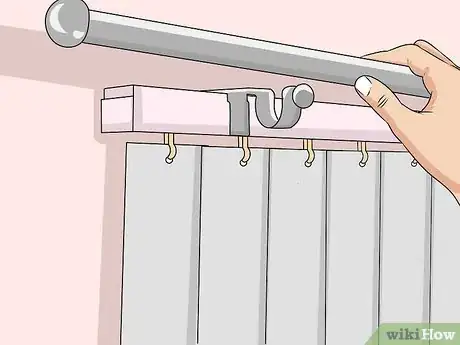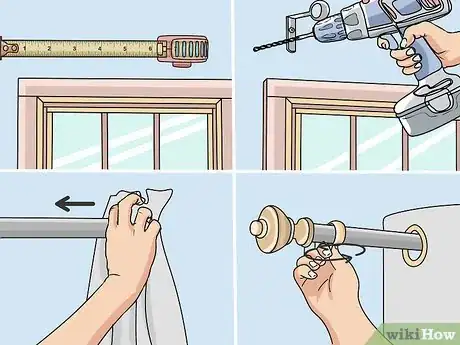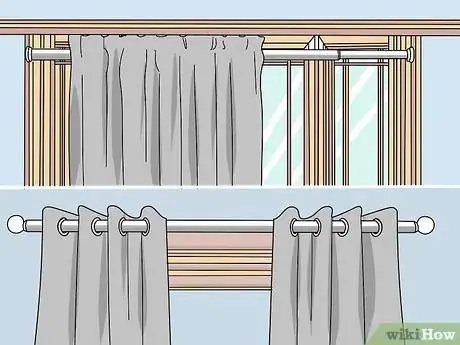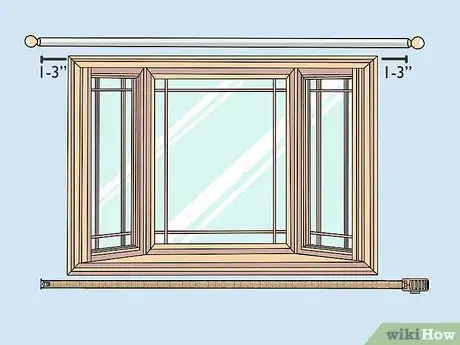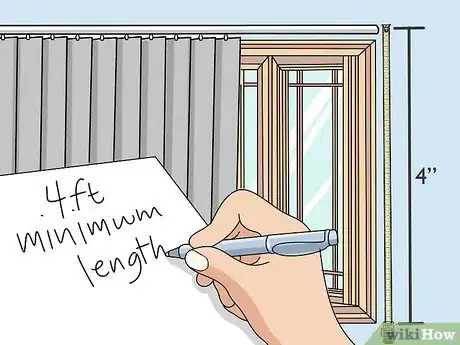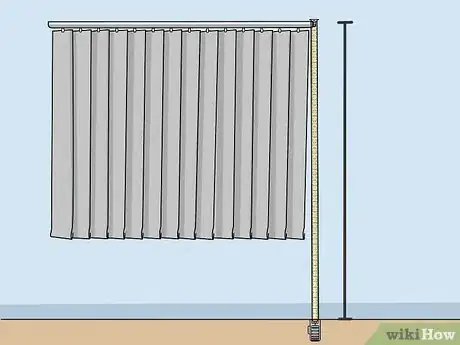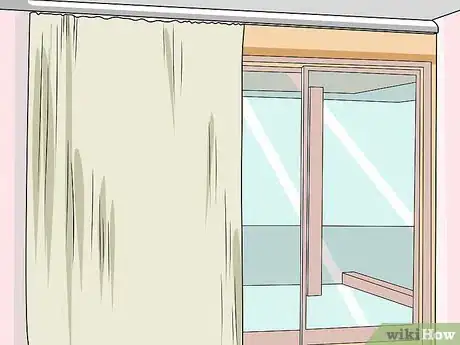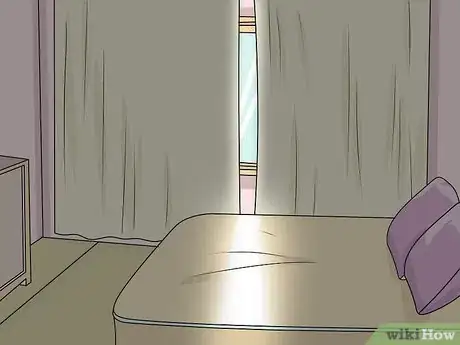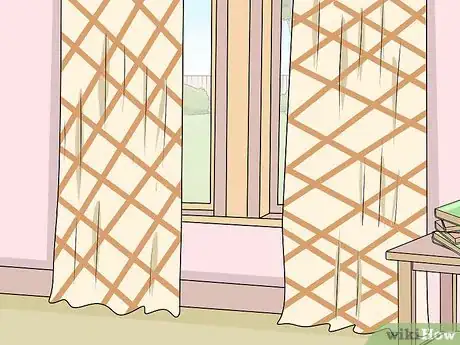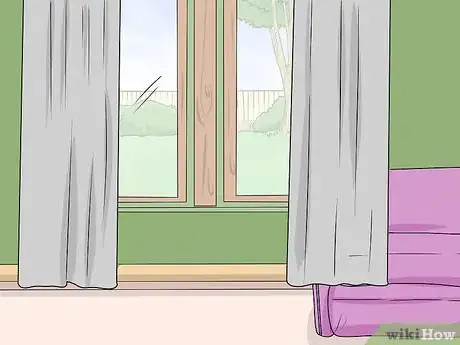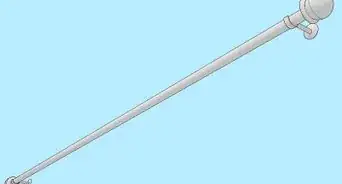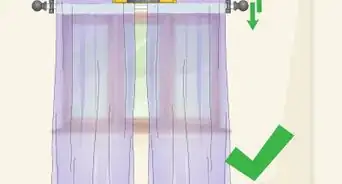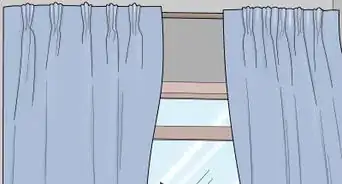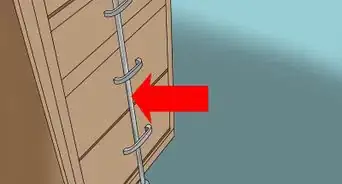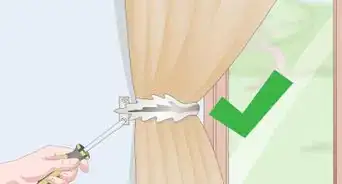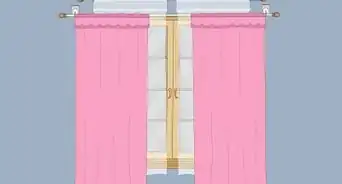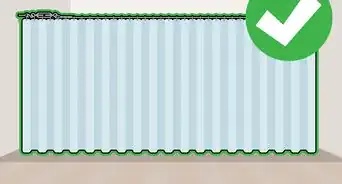This article was co-authored by Karen Parziale. Karen Parziale is a Home Stager, Home Organizer, and the Founder of The Real Estate Staging Studio based in Hoboken, New Jersey. Karen has over 15 years of home staging and decorating experience and has staged over 5,000 homes. She specializes in project management, space planning, material selections, and builder, architect, and client relationships.
This article has been viewed 162,619 times.
Depending on your living situation, you may be faced with vertical blinds that you either can’t take down or don’t want to take down. Thankfully, there are a few easy ways to install curtains overtop of vertical blinds to add some style to your room. Try using a simple tension rod, or, for a more austere style, cover the cornice with curtains hanging from an installed rod. Once you measure for your curtains and pick out the ones you like best, it won’t take you long to hang them up and totally change the look of the room.
Steps
Picking an Installation Method
-
1Use a tension rod to put curtains between the cornice and the blinds. The cornice is an ornamental type of padding that is used to disguise the tops of blinds; they’re often made of plastic or covered with fabric. If you look between the cornice and the blinds, you’ll see that there is space to suspend a tension rod between the 2 sides of the cornice. You can hang curtains from the tension rod and install them within minutes.[1]
- Depending on the setup behind the cornice, you could even use a wooden dowel to hang the curtains.
- If your blinds don’t have a cornice, you could make one yourself to elevate the look of your room even more.
- With a tension rod, you don't have to drill into the wall.[2]
Tip: Tension rods aren’t made to hold a lot of weight, so they’re best used to hang sheer or very light curtains.
-
2Opt for velcro for a no-drill option to attach stationary curtains. Wipe down the inside of the cornice that is covering your vertical blinds to remove any dust or grime. Attach one side of the velcro to the cornice and the other side to the top of the exterior of the curtains. Take your time and make sure that the strips of velcro are lined up evenly. Once you’re done, attach the curtains to the cornice.
- Choose 1⁄2 inch (1.3 cm) wide velcro for sheer curtains. Pick a wider velcro for heavier material.
- The one downfall of using velcro is that you won’t be able to slide your curtains back and forth. But, if you’re mainly interested in the aesthetic rather than the functionality, this shouldn’t be a problem.
Advertisement -
3Install brackets on the cornice to hang curtains in front of the blinds. Buy a set of outside-mounting brackets and a curtain rod. Place the brackets close to either end of the cornice and adjust their settings so that they are firmly holding onto the cornice. Hang the curtains from the curtain rod, and then place the curtain rod in the bracket to complete your project.[3]
- You’ll be able to move your curtains back and forth with this method.
- This is a great option for renters or for people who can’t or don’t want to drill into their walls.
- The most popular bracket is called the “NONO bracket.” It’s super easy to install and doesn’t require any extra tools. There are other similar products you can buy online or at the hardware store.
-
4Remove the cornice and install curtain rods for a fully mobile setup. Use a screwdriver to remove the cornice and its hardware from the wall. Then, measure for the curtain rods and drill into the wall at the appropriate spots. Put the curtains onto the curtain rod and hang them from the brackets.[4]
- If you’re a renter, put the cornice into storage somewhere safe so you can replace it if you move out.
Measuring the Window
-
1Decide on a hanging method before you measure for the curtains. The type of hanging method you use will determine how wide your curtains need to be. For example, if you’re using a tension rod, the curtain will simply extend from one end of the window to the other. But, if you’re installing a curtain rod, you could make the curtains wider than the window itself.
- Remember, you can always hem curtains that are too wide, but you can’t make them wider.
-
2Measure the width of the area you want to be covered by the curtains. Get a tape measure, a pen, and a piece of paper. Extend the tape measure from either one end of the window to the other, or from where you want the curtain to start and stop. Write the measurement down on your piece of paper and label it “width.”[5]
- If the curtains are going to extend out past the window itself, it could be helpful to make a mark on the wall in pencil on either side where you want the curtain to fall. That way, you won’t have to keep remeasuring when it comes time to install the curtains.
Tip: If you’re installing curtain rods, add an extra 1 to 3 inches (2.5 to 7.6 cm) on either side of the window. If you want to create an even bigger visual effect, you could even go out as far as 6 inches (15 cm) on either side.
-
3Stretch the measuring tape from the top of the blinds to the bottom windowsill. This measurement gives you the minimum length that the curtain will need to cover, though it’s very common for curtains to extend further down past the bottom of the windowsill. If the top of the window is too tall for you to reach, use a step-stool.[6]
- Write this measurement down on your piece of paper as “minimum length.”
-
4Measure the distance from the floor to the top of the vertical blinds. If there is something beneath the window frame that you don’t want to obstruct, like a vent or a piece of furniture, measure from the top of that object instead of from the ground. In general, curtains do look best when they reach nearly to the ground, but it’s okay if you need to make modifications.[7]
- This measurement is important so that you don’t purchase curtains that are too long for the space.
-
5Buy curtains that are at least as big as your minimum measurements. Most curtains, unless you have them custom-made, come in a range of standard sizes. If you can’t find the exact length and width that you want, always opt for the next biggest size. If needed, you can always have the curtains hemmed to fit properly.[8]
- If you get curtains that are a bit too small for the window, the room will end up looking strange.
Choosing Curtains
-
1Maximize natural sunlight with sheer curtains. If you love spending time in natural sunlight, using sheer curtains will allow you to have some privacy while still enjoying the natural light, even when the vertical blinds are pulled back. Just remember to extend the vertical blinds at night so that your neighbors can’t see into your home.[9]
- Thankfully, curtains are fairly easy to change out, unless you’re using the velcro method. If you are using the velcro method, hold your curtains up in front of the window to see if you like the way they look before you attach them to the cornice.
- Sheer curtains are super lightweight, making them a great option to hang from curtain rods or velcro.
-
2Reduce noise and light with heavy black-out curtains. Black-out curtains are great for bedrooms, nurseries, or rooms that tend to get too hot during the day because of the sunlight. They can help you sleep better, and they can even help reduce your electric bill since you won’t have to pay as much for air conditioning.[10]
- Black-out curtains normally come in darker shades, like black, navy blue, maroon, gray, and forest green, though there are some shades of cream that you can buy, too.
- Keep in mind that black-out curtains will be too heavy for a tension rod or velcro. They will work best with an actual curtain rod.
-
3Create visual contrast in a room with patterned curtains. There are hundreds of different styles of curtains to choose from, so you will be able to find something that matches your style. Patterned curtains can bring together a space.[11]
- For example, curtains with bright red and yellow flowers could look very appealing in a room with gray-upholstered furniture or a space with a lot of dark wood. The splashes of color would brighten up the room.
- Browse your local home goods store to see what kinds of patterns and colors are available. Think about the style you already have in the room where they’ll be hanging, and try to pick something that will enhance what you already have.
-
4Balance a bright room with neutral-colored curtains. If your walls are covered with art and your furniture pieces are loud and bright, some toned-down curtains might be functional without adding to the visuals of the room. Light grays and creams are great options for a classic look.[12]
- For example, cream-colored curtains would look elegant in a bedroom with bright walls and artwork.
- You can also use lighter-colored curtains in a room that is already fairly neutral. This will help create a calm space.
Expert Q&A
-
QuestionIs it OK to put curtains over vertical blinds?
 Karen ParzialeKaren Parziale is a Home Stager, Home Organizer, and the Founder of The Real Estate Staging Studio based in Hoboken, New Jersey. Karen has over 15 years of home staging and decorating experience and has staged over 5,000 homes. She specializes in project management, space planning, material selections, and builder, architect, and client relationships.
Karen ParzialeKaren Parziale is a Home Stager, Home Organizer, and the Founder of The Real Estate Staging Studio based in Hoboken, New Jersey. Karen has over 15 years of home staging and decorating experience and has staged over 5,000 homes. She specializes in project management, space planning, material selections, and builder, architect, and client relationships.
Home Stager & Interior Designer You can do it, but I usually wouldn't recommend it in most cases. Blinds can look good. Curtains can look good. I don't necessarily see the elegance in getting both.
You can do it, but I usually wouldn't recommend it in most cases. Blinds can look good. Curtains can look good. I don't necessarily see the elegance in getting both. -
QuestionIs curtains over blinds the best way to maintain privacy?
 Karen ParzialeKaren Parziale is a Home Stager, Home Organizer, and the Founder of The Real Estate Staging Studio based in Hoboken, New Jersey. Karen has over 15 years of home staging and decorating experience and has staged over 5,000 homes. She specializes in project management, space planning, material selections, and builder, architect, and client relationships.
Karen ParzialeKaren Parziale is a Home Stager, Home Organizer, and the Founder of The Real Estate Staging Studio based in Hoboken, New Jersey. Karen has over 15 years of home staging and decorating experience and has staged over 5,000 homes. She specializes in project management, space planning, material selections, and builder, architect, and client relationships.
Home Stager & Interior Designer In theory, maybe, but I don't really know if it's necessary. I think if you're going to cover blinds with curtains, the best reason to do it is to cover up some ugly blinds that you can't uninstall because you're renting or something like that. Blinds on their own and curtains on their own are usually more than enough when it comes to privacy.
In theory, maybe, but I don't really know if it's necessary. I think if you're going to cover blinds with curtains, the best reason to do it is to cover up some ugly blinds that you can't uninstall because you're renting or something like that. Blinds on their own and curtains on their own are usually more than enough when it comes to privacy.
Things You’ll Need
- Measuring tape
- Pen and paper
- Curtains
- Hanging implement of choice
References
- ↑ https://youtu.be/1LnTebF-KPM?t=57
- ↑ Karen Parziale. Home Stager & Interior Designer. Expert Interview. 21 April 2020.
- ↑ https://youtu.be/jGstIDZ-7SE?t=10
- ↑ https://www.bobvila.com/articles/how-to-install-curtain-rods/
- ↑ https://www.bobvila.com/articles/how-to-install-curtain-rods/
- ↑ https://www.bobvila.com/articles/how-to-install-curtain-rods/
- ↑ https://www.bobvila.com/articles/how-to-install-curtain-rods/
- ↑ https://www.bobvila.com/articles/how-to-install-curtain-rods/
- ↑ https://www.elledecor.com/home-remodeling-renovating/home-renovation/how-to/a3614/how-to-choose-curtains/#
- ↑ https://www.elledecor.com/home-remodeling-renovating/home-renovation/how-to/a3614/how-to-choose-curtains/#
- ↑ https://www.elledecor.com/home-remodeling-renovating/home-renovation/how-to/a3614/how-to-choose-curtains/#
- ↑ https://www.elledecor.com/home-remodeling-renovating/home-renovation/how-to/a3614/how-to-choose-curtains/#
